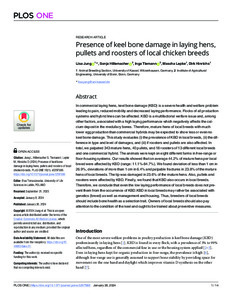| dc.date.accessioned | 2024-02-01T12:51:59Z | |
| dc.date.available | 2024-02-01T12:51:59Z | |
| dc.date.issued | 2024-01-26 | |
| dc.identifier | doi:10.17170/kobra-202402019502 | |
| dc.identifier.uri | http://hdl.handle.net/123456789/15421 | |
| dc.description.sponsorship | Gefördert durch den Publikationsfonds der Universität Kassel | |
| dc.language.iso | eng | |
| dc.rights | Namensnennung 4.0 International | * |
| dc.rights.uri | http://creativecommons.org/licenses/by/4.0/ | * |
| dc.subject.ddc | 630 | |
| dc.title | Presence of keel bone damage in laying hens, pullets and roosters of local chicken breeds | eng |
| dc.type | Aufsatz | |
| dcterms.abstract | In commercial laying hens, keel bone damage (KBD) is a severe health and welfare problem leading to pain, reduced mobility and decreased laying performance. Flocks of all production systems and hybrid lines can be affected. KBD is a multifactorial welfare issue and, among other factors, associated with a high laying performance which negatively affects the calcium deposit in the medullary bones. Therefore, mature hens of local breeds with much lower egg production than commercial hybrids may be expected to show less or even no keel bone damage. This study evaluates (i) the prevalence of KBD in local breeds, (ii) the difference in type and level of damages, and (iii) if roosters and pullets are also affected. In total, we palpated 343 mature hens, 40 pullets, and 18 roosters of 13 different local breeds and one commercial hybrid. The animals were kept on eight different farms in free-range or floor-housing systems. Our results showed that on average 44.2% of mature hens per local breed were affected by KBD (range: 11.1%-84.7%). We found deviation of less than 1 cm in 26.9%, deviations of more than 1 cm in 6.4% and palpable fractures in 23.8% of the mature hens of local breeds. The tip was damaged in 23.6% of the mature hens. Also, pullets and roosters were affected by KBD. Finally, we found that KBD also occurs in local breeds. Therefore, we conclude that even the low laying performance of local breeds does not prevent them from the occurrence of KBD.KBD in local breeds may rather be associated with genetics (breed) as well as management and housing. Thus, breeders of local breeds should include bone health as a selection trait. Owners of local breeds should also pay attention to the condition of the keel and ought to be trained about preventive measures. | eng |
| dcterms.accessRights | open access | |
| dcterms.creator | Jung, Lisa | |
| dcterms.creator | Hillemacher, Sonja | |
| dcterms.creator | Tiemann, Inga | |
| dcterms.creator | Lepke, Mascha | |
| dcterms.creator | Hinrichs, Dirk | |
| dc.relation.doi | doi:10.48662/daks-31. | |
| dc.subject.swd | Geflügelproduktion | ger |
| dc.subject.swd | Hühnerrasse | ger |
| dc.subject.swd | Legehenne | ger |
| dc.subject.swd | Junghenne | ger |
| dc.subject.swd | Hahn | ger |
| dc.subject.swd | Anwesenheit | ger |
| dc.subject.swd | Hühnerkrankheit | ger |
| dc.type.version | publishedVersion | |
| dcterms.source.identifier | eissn:1932-6203 | |
| dcterms.source.issue | Issue 1 | |
| dcterms.source.journal | Plos One | eng |
| dcterms.source.volume | Volume 19 | |
| kup.iskup | false | |
| dcterms.source.articlenumber | e0297586 | |


